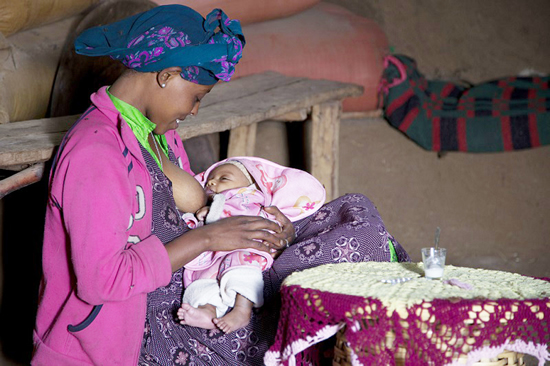Breastfeeding is arguably the best start in life you can give to your newborn baby.
The first week in August is World Breastfeeding Week, an international campaign that supports and promotes breastfeeding to improve babies’ health.
Breastfeeding is arguably the best start in life you can give to your newborn baby. And while it is not always easy, getting advice or help from a professional in the early stages will be well worth the effort for you and your baby.
Why breast is best for baby
Breast milk is easily digestible and has the perfect mix of vitamins, protein and fat, giving babies the best nutrition to help them grow.
In addition to containing all the vitamins and nutrients your baby needs in the first few months of its life, breast milk is packed with disease-fighting substances that protect your baby from a long list of illnesses.
It helps your baby fight off viruses and bacteria, and also reduces your baby’s risk of developing allergies or asthma. Studies also indicate that stomach viruses, lower respiratory illnesses, ear infections, and meningitis occur less in breastfed babies and are less severe when they do occur.
Furthermore, exclusive breastfeeding – where the baby is not fed any solid food, formula or water – is deemed to offer the most protection in the first six months.
The physical closeness in the form of skin-to-skin touching and eye contact promote mother-and-child bonding and helps your baby feel secure.
Benefits for mom
Although breastfeeding can be hard work in the beginning, besides the many health advantages for your baby, you also stand to benefit in many ways.
Firstly, the baby’s sucking during breastfeeding causes the mother’s uterus to contract and reduces the flow of blood after delivery. It also releases a hormone – oxytocin – that not only promotes a feeling of warmth and calm, but also helps your uterus return to its pre-pregnancy size.
In terms of health benefits, breastfeeding lowers your risk of breast and ovarian cancer and research indicates it may also lower your chances of osteoporosis. In addition, it burns extra calories.
And of course when it comes to cost, breastfeeding is the most economical way for you to provide your baby with the nutrition needed without having to spend a cent. It is also convenient and saves you the time and trouble of having to prepare formula and sterilise bottles, allowing you more time to bond with your baby instead.
Many new mothers worry that they don’t have enough milk, and stop breastfeeding in favour of formula when they see their baby’s weight dropping.
However, remember that some weight loss in the first few days is completely normal and most babies return to their birth weight within two weeks of delivery. Normal weight gain is between 20 and 30 grams per day, or between 150 and 210 grams per week.
If your baby is not steadily gaining weight every week, your midwife or nursing professional will be able to advise you whether you should be topping up with formula.
How to breastfeed
Everyone will have their own opinion when it comes to how you should breastfeed your baby. However, what works for someone else may not necessarily work for you.
It’s best to take it day by day and find what works best for you and your baby. Let your baby feed when it is hungry or you will risk decreased milk production for yourself and poor weight gain for your baby.
- Make sure you are sitting comfortably and you are well supported.
- Hold your baby close to you, facing your chest.
- Position your baby on his side, with his nose opposite your nipple.
- Support your breast from underneath.
- Position your fingers well back from the areola/nipple, so your can take a big mouthful of breast tissue.
- Touch your baby’s lips with your nipple to encourage him to open his mouth wide.
- Make sure your baby’s mouth is very wide (like yawning), then bring him to the breast quickly, chin first.
- Make sure your baby’s bottom lip is well down over the areola, ‘off centre’.
- Continue to support your breast until your baby is sucking and swallowing, in a deep rhythmic pattern.
- If you experience pain once your baby has started swallowing, take your baby off and re-attach.
- Remember to insert a clean finger between the baby’s gums, to break the seal when taking your baby off the breast.
You know your baby is feeding well when:
- After some initial short frequent sucks to stimulate milk flow, your baby begins to swallow. Sucking becomes slower, deeper and more rhythmic with rest periods between each sucking burst. As the feed progresses, the sucking bursts become shorter and the rest periods longer.
- You can hear or see your baby swallowing.
- Your baby is settled after most feeds.
- Your baby is alert, active and content when awake.
- Your baby has at least six soaked cloth nappies, in 24 hours, after your milk ‘comes in’; disposable nappies should be heavy and spongy.
- Your baby has at least one yellow, loose bowel action every day, after initial meconium (the first bowel action) has passed.
Where to get help and support Talk to the nurses at your local hospital or clinic. La Leche League of South Africa is a voluntary organisation that provides information and support to women who want to breastfeed their babies. www.llli.org/SouthAfrica.html
info@motherinstinct.co.za provides a list of lactation experts and support groups
Source: National Department of Health and Government Employees Medical Scheme



 Facebook
Facebook Twitter
Twitter WhatsApp
WhatsApp